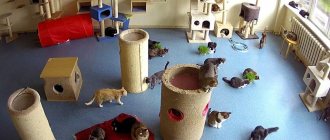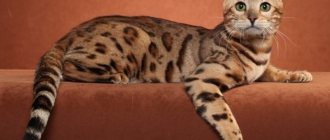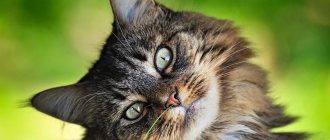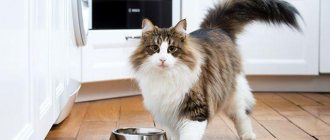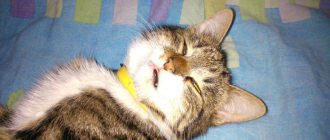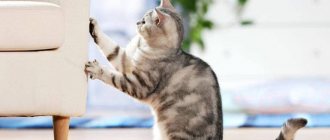Pixie bob
To develop a breed of cat that resembles a lynx, breeders used short-tailed forest cats. These animals live in the forests of North America. The first cat obtained in this way was named Pixie, which means “Elf” or “Fairy” in English.
The animals are distinguished by a short tail, tufts on the ears and whiskers are possible. Pixies are unpretentious, train well and easily make contact with people.
History of the discovery of the species
The puma belongs to the predatory mammals of the cat family. In Latin, its designation sounds like puma concolor, where puma is the name of the cat, coming from the language of the American Quechua Indians, and concolor is translated as monochrome and reflects the monochromatic color of an adult animal - silver (in the northern regions) or reddish (in the southern regions). Close relatives of the puma are the wild cat Jaguarundi and the extinct cheetah Miracinonyx from North America. Despite its considerable size, the puma is one of the small cats that cannot growl due to the complete hardening of the hyoid bone.
Jaguarundi is a small predatory cat, the closest relative of the puma
One of the first descriptions of the puma was made in 1553 by Pedro Cieza de Leon, a Spanish traveler and geographer, in the book Chronicle of Peru. This book can be considered the first encyclopedia on the geography, botany and zoology of South America.
Indian tribes paid a lot of attention to these animals, but in different ways: the Incas saw pumas as associated with the deity of sky and thunder, the Apaches considered their cries to be harbingers of death, and among the Cherokees, pumas were a sacred animal and were inviolable. The name puma was often included in a person's complex name to give him strength and agility.
The Spaniards, who came to the South American continent at the end of the 16th century, experienced problems with pumas: they happily hunted cattle, and the Indians forbade the destruction of predatory cats. Even a whole bull as a gift for a killed puma could not change the opinion of the local population. The Indians hung the claws of the beast in their homes, thus driving away evil spirits. And about the sacred animal’s hunting of livestock, they said this: “The puma is a poor child who has taken the wrong path.”
The beauty and grace of the puma delighted settlers of the New World for many centuries, and its agility and cunning made them constantly fear this beautiful predator.
In ancient times, the living space of cougars was very extensive: from southern Alaska to the Strait of Magellan. After the conquest of America by white people, pumas were hunted everywhere, first to protect livestock, and then for the sake of beautiful skins and meat. They even gave a bonus for the killed individual. And only in the 20th century, when predators were on the verge of extinction, hunting for pumas was prohibited and numerous reserves appeared.
Now the puma species includes 6 subspecies, differing in size and color. Cougars live in the mountainous regions of North and South America, on plains, and less often in forests and swampy areas.
California shining cat
The famous screenwriter Paul Casey was involved in the origin of this breed. On his trip to Africa, he decided to preserve the unique colors of wild cats on the skins of domestic animals.
Many breeds took part in the creation of the new species: Manx, British, Siamese, Angora and Abyssinian cats. Eventually, the Californian shining cat appeared, so named for its unusual color.
The breed immediately found many admirers. They say that the Californian cat is a link between humans and wild nature. At the same time, they do not forget to advertise the new breed everywhere.
TOP 10 wild cats that can be kept at home
Content
- 10th place – Cheetah
- 9th place – Ocelot
- 8th place – Canadian lynx
- 7th place – Vivver cat (fisher)
- 6th place – DLK (Far Eastern forest cat)
- 5th place – Jaguarundi
- 4th place – Geoffroy
- 3rd place – Karakal
- 2nd place – ALC (Asian leopard cat)
- 1st place – Serval
Recently, more and more people would like to have an unusual, exotic animal at home. And since there are a lot of cat people in our country, many people keep wild cats at home.
In this article, we will look at feral cats that are suitable for pet keeping, in order of their popularity.
10th place – Cheetah
The cheetah's temperament is more like a dog than a cat. Cheetahs have a gentle and peaceful disposition, so they can quickly get used to a leash and collar. When a cheetah is happy, it purrs like a house cat.
Cheetahs are quite easy to tame, and they show high training abilities.
An adult cheetah can weigh more than 45 kg.
Cheetahs are very curious
Cheetah looks more like a dog than a cat
Domestic cheetah
Domestic cheetah
9th place – Ocelot
Ocelot is a small wild cat. In terms of habits, it is close to Serval.
To keep Ocelot at home, you will need to spend a considerable amount to provide him with the necessary conditions for living. This is a very jumping cat and loves to climb to heights.
Ocelot's weight is from 10 to 16 kg.
Contents Ocelot at home
Ocelot is a wild cat, small in size.
Ocelot can become an affectionate cat
Salvador Dali and Ocelot
8th place – Canadian lynx
The Canadian lynx is a large, powerfully built cat with a powerful skeleton and very long legs. They are quite unpretentious and adapt well to home keeping.
The weight of an adult Canadian lynx is up to 16 kg.
Canada lynx
Canada lynx
7th place – Vivver cat (fisher)
The civet fishing cat is a fairly large representative of the cat family. These cats get along with people, subject to certain rules. Such cats are tamed from infancy so that they are not afraid of humans and do not consider them their enemies.
The weight of a male Vivever cat is usually 11-15 kg.
Viverrid cat-fisher at home
Viverrid cat-fisher at home
6th place – DLK (Far Eastern forest cat)
Training follows the same method as taming domestic cats. Read more about keeping the Far Eastern leopard cat at home in our article.
The weight of a male Far Eastern forest cat reaches 15 kg.
Far Eastern forest cat
Far Eastern forest cat
5th place – Jaguarundi
The Jaguarundi is a special cat. This is the first cat domesticated by the Indians. In addition to the fact that jaguarundis are unusual in appearance, they are also diurnal. The Jaguarundi is an excellent swimmer, but does not like to climb trees. This cat is very easy to tame.
The weight of these cats is no more than 10 kg.
Jaguarundi is a special cat
Jaguarundis come in different colors
Jaguarundis come in different colors
4th place – Geoffroy
Geoffroy's cat is a small cat from America. Such a cat needs to be tamed from an early age. It can be kept both in a private house (or apartment) and in an enclosure. Geoffroy is a very playful cat, loves company and affection. They are easy to train once you have tamed it.
Geoffroy's weight does not exceed 8 kg.
Geoffroy's cat
Geoffroy's cat
3rd place – Karakal
The caracal is one of the most popular wild cats kept as a pet. Without a doubt, Caracal is more than just a cat. To maintain such a “kitty” you will need not only large financial investments, but also all your time. In general, these animals can be trained, but this requires a lot of effort and a lot of time.
It will not be possible to keep such a pet in an apartment; they need their own outdoor enclosure.
The weight of an adult male Caracal can reach 20 kg.
Home Caracal
Home Caracal
Home Caracal
2nd place – ALC (Asian leopard cat)
ALC is the second most popular wild cat kept at home. The appearance of this cat resembles a mini-leopard. With proper upbringing, ALC takes root in an apartment or house. She will be especially comfortable if you have an outdoor enclosure.
The weight of the Asian leopard cat is 5-7 kg.
ALK (Asian leopard cat)
ALK (Asian leopard cat)
ALK (Asian leopard cat)
1st place – Serval
The Serval is the most popular wild cat to keep at home.
The Serval's personality is quite friendly, more like a dog's than a cat's. Servals become strongly attached to one owner, and, like dogs, are loyal to him all their lives. Servals are very fond of outdoor games and love to jump high.
The serval, like a dog, can protect itself and its owner.
If Serval is raised correctly, he will grow up to be a devoted, faithful, like a dog, affectionate and loving cat.
The Serval's weight usually does not exceed 18 kg.
Home Serval
Home Serval
Think before you bring a wild cat into your home! This is a very serious step! A wild cat needs your full attention, like a child. Such a cat needs to be created with the most comfortable living conditions - an outdoor enclosure for games, large areas for running, a very large number of toys. It is also necessary to equip the place where the wild cat will live with various shelves, hammocks, and places to sleep.
It is important to note that a wild cat should be purchased at a very early age so that you can tame and raise it.
Keeping a wild cat at home is very difficult and expensive. But if you really want to, but you don’t have the knowledge, conditions, or money, then wild cat hybrids are suitable for you. Read our article “Hybrid breeds from wild cats.”
The Serval's weight usually does not exceed 18 kg.
Bengal cat
The idea of crossing a wild Bengal cat with its domestic relatives came to the mind of American Jean Mill back in 1961. The young woman was then in Southeast Asia, engaged in scientific research.
Jean bought a small kitten at a local market and brought it to the United States. The cat grew up, but remained wild and did not make contact at all. However, soon the touchy-feet grew warmer - a domestic black cat came into her field of vision. The couple gave birth to a Bengal baby. This was the first result of interspecific crossing.
A little about my personal life with a new appearance
Despite her, without exaggeration, terrifying appearance, Jocelyn Wildenstein leads an active social life. At the same time, she is constantly in the company of men. Her last crush was fashion designer Lloyd Klein, with whom she has a 17-year age difference. The paparazzi are constantly hunting for Jocelyn. A man shows care and protection to his beloved, shielding her from camera flashes.
How real their relationship is is unknown, but they broke up not long ago. More precisely, Jocelyn attacked the man with scissors when he did not want to “break away” from his mobile phone.
After this incident, the payment of alimony was stopped. And now Jocelyn needs to earn her own living. She has already decided to sell off some of the real estate that she is not using.
We recommend reading about Demi Moore before and after plastic surgery. You will learn about the first interventions the star underwent, Botox injections, the results of plastic surgery and what Demi Moore looks like now. And here is more information about Jennifer Aniston's plastic surgery.
Jocelyn Waldenstein or Catwoman shows by her example how far one can go in search of the “ideal”. Complete reshaping of the face leads not only to real ugliness, but also to serious health problems in general. Plastic surgery is a responsible step. A negative result cannot be “returned to the store” or redone. Traces of the mistake will forever remain on your face, which you will have to live with.
Savannah
The large and powerful Savannah is the most expensive cat in the world. In the eighties of the last century, a domestic cat was crossed with a serval, resulting in a very beautiful and unique animal.
The Savannah has an elongated neck and slender legs. The color can be different - chocolate, gold, silver. The animal is considered an intellectual in the cat family. The cat's extraordinary intelligence is visible in her eyes - they are large and unusually expressive.
They are talking
Your domestic cat meows, purrs and growls. Big cats also have their own vocalizations, and some of them are very similar to the sounds made by a domestic cat. “There are big cats: lions, tigers, leopards and jaguars. And they roar,” says Bass. “They have a special bone in their throat that allows them to do this. And the so-called small cats (come on, we know that there is no such thing as a “small cat”), including lynxes, pumas, and bobcats, cannot roar. It probably has to do with where they live,” Bass says. “Lions live in the vast African savannahs. And one lion must hear the roar of the other at least within a radius of 5 km. Leos should be able to do these things. But the Canada lynx, living in the snowy mountains, does not need to roar loudly to indicate its presence.”
But roaring is far from the only way big cats communicate. "They're all talking," Bass says. “And they all make a lot of different sounds.” Almost all small cats can purr, and tigers make intermittent sniffles, as if they are blowing air through closed lips.” Bass says it's a greeting. “Like my house cat, big cats talk to people. Some of them are very talkative, others do not make too many sounds. Here's one of our cougars, Raze, who really loves to talk. You approach her, and then she suddenly “bruh-ruh rukh.” You can also watch Raze play football here.”
Interesting fact: the offspring of the four “great cats” are called “cubs,” but the offspring of the “small cats” are called “kittens.”
Toyger
The creator of the breed is Judy Sugden, the daughter of the famous explorer Jean Mill, who gave the world the Bengal. Toygers look like toy tigers. Bright stripes on the skin and specific markings on the head make them look like their wild counterparts. They not only captivated cat lovers, but also immediately became welcome participants in various exhibitions.
There are quite strict requirements for toygers - a representative of the breed must have plush fur and horizontal stripes on the body. These cats' ears are usually round and their eyes are small.
Description of Lykoi
Werecats differ from other members of the family in a number of unique qualities. They concern not only the color of the coat, but also the structure of the body.
Body
The Lykoy breed is distinguished by a regular, but slightly thin build. A slightly elongated body with flexible and strong muscles allows the animals to show both dexterity and power. The tail is long and tapering towards the tip, but it is shorter than the body. The weight of the Lika cat is average according to cat parameters.
Limbs
The well-developed thin paws of a werewolf cat are of medium length. At the same time, the hind limbs of catwolves are slightly shorter than the front ones. The lower part of the limbs is bare. The paw pads are medium sized and slightly oval in shape.
Head
The wedge-shaped head of cats has rounded edges and a slightly elongated forehead. The overall dimensions of the head are average or slightly less than average. The whisker pads on the muzzle are fleshy with soft outlines. The nose is slightly pointed downwards and has a soft rounding.
A prerequisite according to the breed standard is a bald muzzle. If this condition is not met, the cats will be disqualified. The werecat's large ears are characterized by a wide base and pointed tips. The ears are set wide apart.
The eyes, large as a walnut, are located slightly obliquely upward. Lykoi cats attract attention with an open and piercing gaze. Kittens are most often born with yellow irises.
Wool
The coat is a distinctive feature of the Lykoi cat breed. It is soft, but not dense. Hair length ranges from short to medium. The total number of hairs depends on the time of year. The undercoat is extremely weakly expressed. When comparing the fur of werecats, the most common example cited is the opossum.
The color of Lykoi cats is black with gray hair. In professional language it is called roan: the base of the hair is white or light gray, and the tip is black. If kittens are born in a litter that, along with the roan, have a different shade of fur, then they are left among the purebred ones, but are not allowed to take part in high-ranking exhibitions.
Pantheretta
This black beauty was born almost by accident. One of the litters of Bengal cats once gave birth to a black baby. The little one grew and became more and more like a panther in appearance.
The breeders did not ignore the amazing similarity, and selection work led to the creation of a new breed. Pantheretta cannot be bought: the work of researchers is not yet finished. Cats of this breed are very friendly, distinguished by good health and indescribable elegance.
